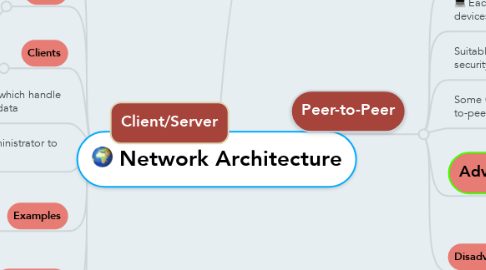Network Architecture
by ashie shi


1. Client/Server
1.1. A network in which one or more computers act as a server, and the other computers, called client, request services from the serve
1.2. server
1.2.1. a computer that controls access to hardware, software and other resources on the network and provides a centralized storage for programs, data and information
1.3. Clients
1.3.1. other computers or devices on the network that rely on the server for its resources
1.4. Efficient for large network which handle sensitive and confidential data
1.5. Require a network administrator to manage the network
1.6. Examples
1.6.1. email service (ex: g-mail)
1.6.2. automated teller machine (ATM) network
1.7. Advantages
1.7.1. Data backup and recovery is easier since all data is stored in the server
1.8. Disadvantages
1.8.1. High cost to to set up and maintain the network
2. the design of computers, devices, and media on the network
3. Peer-to-Peer
3.1. have equal capabilities and responsibilities to share hardware, data or information with other computers on the network
3.2. Each computer stores files on its own storage devices
3.3. Suitable for small network where high level security is not necessary
3.4. Some OS, such as Windows, include a peer- to-peer networking utility
3.5. Advantages
3.5.1. Easy and inexpensive to set up the network
3.5.2. All the peers can share their resources to others
3.6. Disadvantages
3.6.1. Lack of security control or other management functions
3.6.2. Data recovery or backup is very difficult
